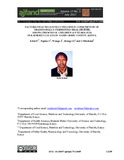Factors that negatively influence consumption of traditionally fermented milk (mursik) among preschool children (1-5 years old) in Kapseret location-Uasin Gishu County, Kenya.

View/
Date
2017Author
Kirui, E
Nguka, G
Wango, J
Abong, G. O
Muchemi, G.
Type
ArticleLanguage
enMetadata
Show full item recordAbstract
Traditionally fermented milks are widely consumed in various countries of sub-Saharan
Africa and a number of health benefits to human beings are attributed to them. However,
available studies show that children less than 5 years old consume milk mainly as fresh
milk or when added to tea or porridge. Therefore, information on consumption of
traditionally fermented milk by children is scanty, yet factors hindering its consumption
have rarely been studied. The objective of this study was, therefore, to establish factors,
which negatively influence consumption of Mursik, a traditionally fermented milk product
from the Kenyan Rift Valley, Uasin Gishu County. This will have a positive impact on its
consumption and hence increased nutritional status and health among children. The study
sought to determine average weekly household mursik production, quantity and the extent
of consumption by children less than five years and their association with sociodemographic
and economic characteristics of households. A cross-sectional descriptive
study involving 383 Kalenjin households was conducted within Kapseret location in
August 2013. Structured questionnaires and a focused group discussion (FGD) question
guide were the main instruments of data collection. The baseline survey showed that only
32% of households fed their children mursik and they fed a mean quantity of 250 ml per
week or 12 kg annually. Education level of respondents (χ
2 = 0.116, P= 0.025), household
mursik production levels (χ
2 = 0.1311, P=0.001) and respondents’ nutrition knowledge of
mursik (χ
2 =0.154, P=0.005) negatively influenced mursik consumption among pre-school
children. Results further indicated that although a majority (86.4%) of respondents had
average nutrition knowledge of mursik, the application of these nutrition concepts was
lacking. This might be due to socio-economic factors, cultural beliefs, attitudes and/or
negative perceptions among respondents of mursik consumption by young children. There
seems to be urgent need for a well-designed nutrition intervention program, sensitizing
mothers and the population in general on the importance of traditionally fermented milk
(mursik) for children and as a transition food that is locally available, affordable and
culturally acceptable.
URI
https://www.cabdirect.org/cabdirect/abstract/20173336815?q=(((%22university+of+nairobi+2017%22+OR+(university+of+nairobi+2017))))http://hdl.handle.net/11295/103431
Publisher
University of Nairobi
Rights
Attribution-NonCommercial-NoDerivs 3.0 United StatesUsage Rights
http://creativecommons.org/licenses/by-nc-nd/3.0/us/Collections
The following license files are associated with this item:

